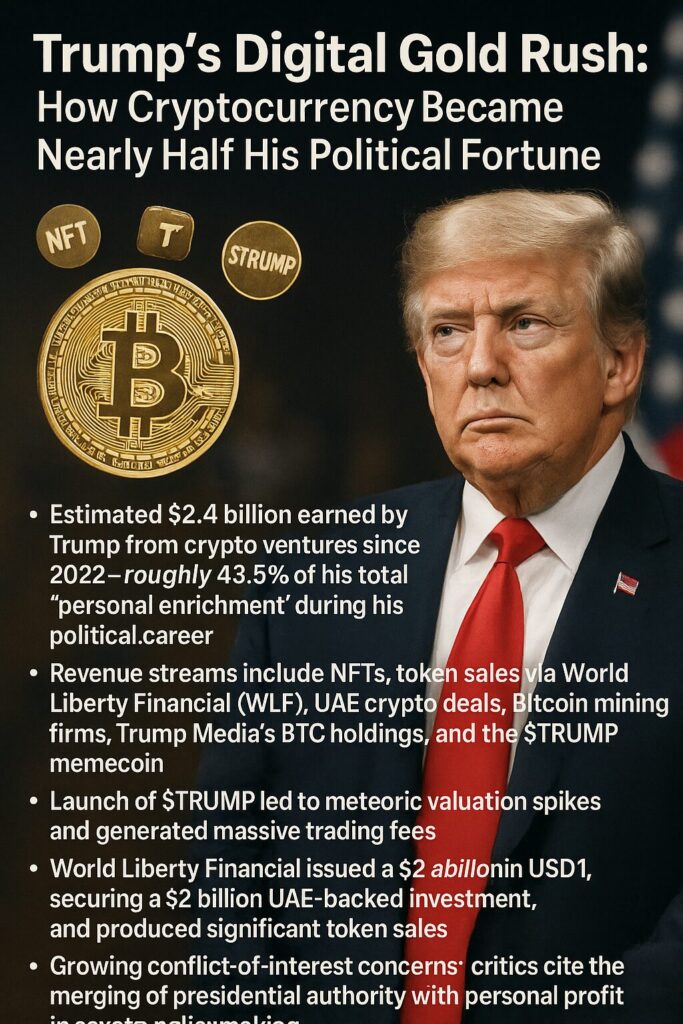
Main Points:
- Estimated $2.4 billion earned by Trump from crypto ventures since 2022—roughly 43.5% of his total “personal enrichment” during his political career.
- Revenue streams include NFTs, token sales via World Liberty Financial (WLF), UAE crypto deals, Bitcoin mining firms, Trump Media’s BTC holdings, and the $TRUMP memecoin.
- Launch of $TRUMP led to meteoric valuation spikes and generated massive trading fees.
- World Liberty Financial issued stablecoin USD1, secured a $2 billion UAE-backed investment, and produced significant token sales.
- Growing conflict-of-interest concerns: critics cite the merging of presidential authority with personal profit in crypto policymaking.
- The Trump administration has deregulated crypto, halting enforcement actions and encouraging broader crypto integration across U.S. finance.
1. The Crypto Windfall
Donald Trump’s ventures into cryptocurrency since 2022 are estimated to have netted him approximately $2.4 billion, accounting for about 43.5% of the wealth he has accrued in his political career. The revenue breakdown includes:
- $14.4 million from NFT collections
- $412.5 million via token sales from World Liberty Financial
- $243 million through crypto deals with the UAE
- $13 million from Bitcoin mining with American Bitcoin
- $1.3 billion from BTC holdings via Trump Media & Technology Group
- $385 million generated by the official $TRUMP memecoin.
2. $TRUMP: Meme Coin Mania
On January 17, 2025, Trump launched the $TRUMP meme coin on Solana via CIC Digital LLC, which controlled 80% of the coin’s supply. Within hours, the total market value soared:
- The coin reached a $27 billion diluted valuation
- Generated $350 million+ in token sales and transaction fees.
- Though valuations later cooled, actual profits from the venture were estimated at $385 million.
This explosive rise and the promotional tactics—such as a VIP dinner for major holders—have raised ethics questions, with critics likening it to a “pump-and-dump” scheme.
3. World Liberty Financial & USD1 Stablecoin
World Liberty Financial (WLF), founded in 2024 and majority-owned by the Trump family, issued the $WLFI token and later launched the stablecoin USD1, pegged to U.S. dollars and treasuries.
- WLF funneled $412.5 million to the Trump family from token sales.
- In 2025, a UAE firm invested $2 billion using USD1 via Binance’s infrastructure.
- The stablecoin surged in usage, and WLF emerged as one of the family’s most lucrative ventures.
4. Easing Regulations & Policy Shifts
Under the Trump administration’s second term, crypto regulations were significantly relaxed:
- The SEC dropped or paused enforcement actions against Angel firms like Coinbase, Uniswap, and reportedly encouraged traditional banks to embrace crypto assets.
- The DOJ disbanded its specialized crypto fraud unit, signaling broader deregulation.
- Institutions began integrating crypto into retirement accounts and mortgages—accelerating financial integration with digital assets.
These shifts have heightened concerns about presidential conflict of interest, with critics arguing that Trump’s policy decisions facilitate personal and family profit.
5. Conflict of Interest: Crossing the Ethical Line
Ethics watchdogs and legislators criticize the intertwining of Trump’s crypto profits with presidential power:
- Senator Elizabeth Warren demanded SEC transparency over Trump Media’s ETF and crypto dealings, citing unprecedented conflicts of interest.
- Critics point to foreign involvement—like Justin Sun and UAE backers in WLF—as avenues for covert influence, potentially violating emoluments provisions.
- Observers warn the situation may normalize high-level financial entanglement and erode public trust.
Summary & Conclusion
Donald Trump’s foray into cryptocurrency has proven remarkably lucrative—$2.4 billion in earnings across NFTs, token sales, memecoins, and stablecoins. The $TRUMP meme coin and USD1 stablecoin stand out as powerhouse drivers. Meanwhile, a deregulatory regime has reshaped U.S. crypto policy, smoothing the path for his ventures. Ethical concerns abound, from conflicts of interest to foreign involvement, prompting calls for regulatory scrutiny.
For crypto enthusiasts and practitioners exploring new opportunities, these developments underscore two key takeaways:
- Blockchain market potential remains vast—and real money is at stake through tokenization and novel financial instruments.
- Regulatory oversight is critical. The Trump case exemplifies how blurred lines between state power and personal profit can distort markets.
As crypto becomes increasingly embedded in global finance, vigilance, transparency, and robust governance will determine whether it fosters innovation—or facilitates extraction.

